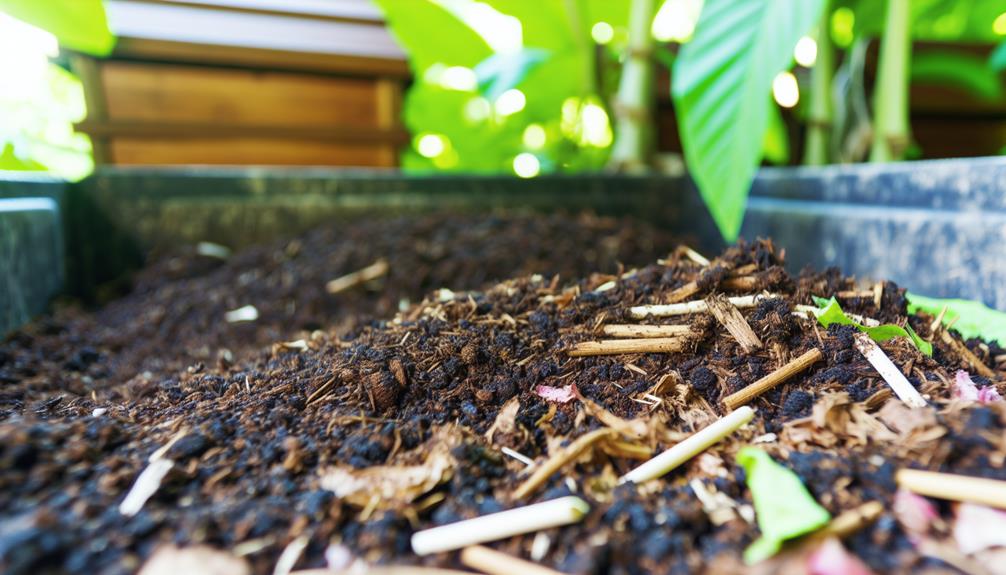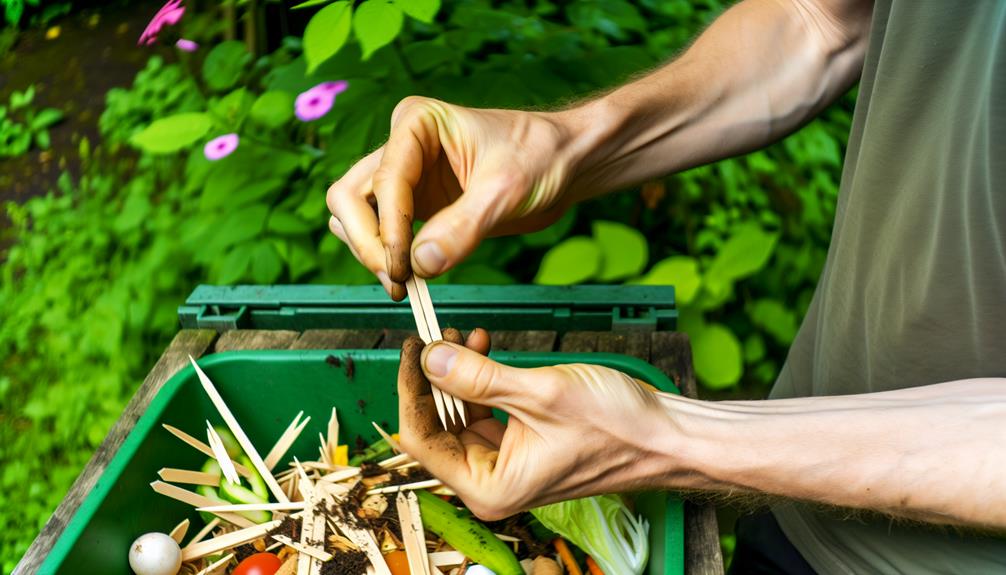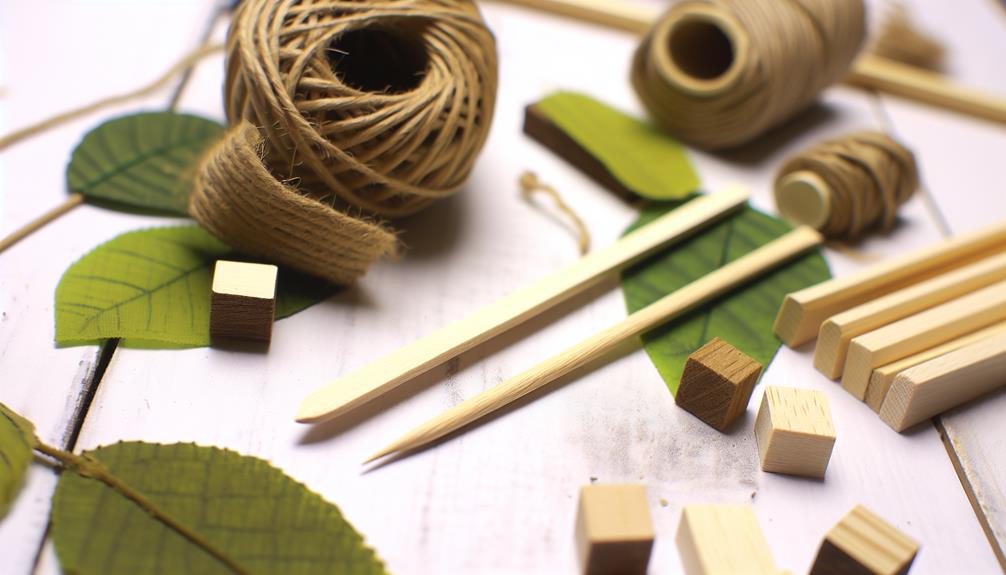

Yes, you can compost wooden toothpicks if they are natural and untreated. Break them into smaller pieces to speed up decomposition. Mix them with other compostable materials to maintain a balance of ‘greens’ (nitrogen-rich) and ‘browns’ (carbon-rich).
Make sure your compost pile is regularly turned for aeration and kept moist but not soggy. Natural wooden toothpicks will gradually break down, enriching your soil with valuable nutrients. Avoid composting flavored or colored toothpicks, as they might contain additives. Learn how to optimize your compost pile by exploring further.
Wooden toothpicks are slender, pointed sticks made from wood, typically used for dental hygiene and food handling. You might be surprised to learn that these small tools have a significant history. They date back to ancient civilizations, where they were used not just for cleaning teeth but also as status symbols. Over time, their practical utility remained, and they became a staple in households and restaurants worldwide.
Understanding the manufacturing process of wooden toothpicks can give you a deeper appreciation for these seemingly simple items. It starts with selecting the right type of wood, usually birch or bamboo, known for their strength and flexibility. The wood is then cut into small blocks and boiled to soften it. Next, the blocks are sliced into thin sheets and cut into individual toothpicks. These toothpicks are then polished to remove splinters and ensure a smooth finish.
Not only is the process fascinating, but it also guarantees you get a reliable product for everyday use. Knowing the history and manufacturing process of wooden toothpicks helps you see them not just as disposable items, but as tools with a rich heritage and thoughtful craftsmanship.
Also Read: Can You Compost Black-Eyed Peas?
Considering their rich history and intricate manufacturing process, it’s fascinating to explore the various types of wooden toothpicks available today. You might be surprised at the variety you can find, each serving unique purposes and preferences. From basic wooden toothpicks to more specialized versions, there’s something for everyone.
Flavored toothpicks are an intriguing option. These are often infused with flavors like mint, cinnamon, or even whiskey, offering a pleasant taste and a bit of freshness. They not only help clean your teeth but also leave a lasting flavor.
Colored toothpicks are another popular choice. They come in various hues, making them perfect for parties and gatherings. These toothpicks add a splash of color to your appetizers and are easy to spot, reducing the likelihood of someone accidentally ingesting one.
For clarity, here are three key types of wooden toothpicks:
Exploring these types can help you choose the best wooden toothpicks to suit your needs, whether for practical use or adding a bit of flair to your events.
Also Read: Can You Compost Celery?
Composting is a simple and effective way to recycle organic waste into nutrient-rich soil for your garden. Understanding the basics of composting can help you turn kitchen scraps, yard waste, and even wooden toothpicks into valuable compost. First, collect your organic matter; this includes fruit and vegetable peels, coffee grounds, eggshells, and yard clippings. Avoid meat, dairy, and oily foods as they can attract pests.

Next, choose a compost bin that suits your space. You can use a simple pile in the corner of your yard, a purchased bin, or even a homemade one. The key to successful composting is maintaining a balance between “greens” (nitrogen-rich materials) and “browns” (carbon-rich materials).
| Green Materials | Brown Materials | Tips for Success |
|---|---|---|
| Fruit scraps | Dry leaves | Turn your pile weekly |
| Vegetable scraps | Cardboard | Keep it moist, not wet |
| Coffee grounds | Paper | Add air for aeration |
| Grass clippings | Wood chips | Avoid large chunks |
Remember to turn your compost regularly. This helps to aerate the pile and speeds up decomposition. Keep your compost moist, but not too wet, and make sure it gets plenty of air. Happy composting!
Now that you’ve grasped the fundamentals of composting, let’s explore how wooden materials, like toothpicks, break down in the compost pile. The decomposition of wood involves complex wood chemistry and is driven by microbial activity. These microbes, such as bacteria and fungi, feed on the cellulose and lignin in the wood, gradually breaking it down into simpler compounds.
To effectively compost wooden toothpicks, consider these points:
Also Read: Can You Compost Basil?
You’ll find several compelling benefits to composting wooden toothpicks, from reducing landfill waste to enriching your soil with valuable nutrients. By composting, you directly contribute to waste reduction, ensuring that these small wooden items don’t end up in landfills. This action not only helps the environment but also fosters a sense of community responsibility.
One of the primary advantages of composting toothpicks is soil enrichment. Wooden toothpicks break down into organic matter that enhances the nutrient content of your compost. This enriched compost, when added to your garden, improves soil structure, moisture retention, and provides essential nutrients to plants. It’s a simple yet effective way to promote a healthier garden without relying on chemical fertilizers.
Additionally, composting wooden toothpicks is an easy habit to incorporate into your daily routine. Place a small compost bin in your kitchen for convenience. Over time, you’ll notice that even small items like toothpicks can make a significant difference in your compost pile.
While composting wooden toothpicks offers numerous benefits, it’s important to be mindful of potential issues that could arise in the process. One major concern is the presence of toothpick coatings. Many wooden toothpicks are coated with chemicals or wax to improve durability and aesthetics. These coatings can hinder the composting process and may even introduce harmful substances into your compost pile.
Another issue to take into account is the environmental impact. Improperly composted toothpicks can contribute to environmental pollution. Wooden toothpicks may take longer to decompose compared to other compostable materials, especially if they’re not broken down into smaller pieces. This slow decomposition can delay the enrichment of your compost.
Here are some potential problems you might encounter:
Being part of an eco-conscious community means recognizing these challenges. By staying informed, you can take steps to mitigate these issues, ensuring your composting efforts are both effective and environmentally friendly.
Also Read: Can You Compost Barbecue Sauce?
To prepare wooden toothpicks for composting, start by inspecting them for any coatings or chemicals. Some toothpicks might’ve varnishes or dyes that aren’t compost-friendly. If you’re uncertain, it’s best to discard those to avoid contaminating your compost pile.

Once you’ve confirmed your toothpicks are free of harmful substances, break them into smaller pieces. This step in toothpick preparation helps speed up the decomposition process. Smaller pieces provide more surface area for microbes to work on, facilitating quicker breakdown and integration into your compost.
Next, soak the broken toothpicks in water for a few hours. This softens the wood, making it easier for microorganisms to start the composting process. While soaking isn’t strictly necessary, it can give your compost preparation a head start.
After soaking, drain the water and mix the toothpicks with other compostable materials like kitchen scraps and yard waste. Make sure to balance ‘browns’ (carbon-rich materials) and ‘greens’ (nitrogen-rich materials) to maintain an effective composting environment.
Also Read: Can You Compost Artichoke?
To effectively manage your compost pile, you’ll need to keep an eye on temperature, moisture levels, and aeration.
Make sure the pile stays warm but not too hot, and guarantee it’s consistently damp, not soggy.
Regularly turn the pile to introduce oxygen and help the decomposition process.
Maintaining the right temperature in your compost pile guarantees efficient decomposition of wooden toothpicks and other materials. To achieve ideal temperatures, aim for a range between 135°F and 160°F. This thermal regulation ensures that microorganisms are active enough to break down the compost ingredients effectively.
To keep your compost at these ideal temperatures, follow these tips:
How often do you check the moisture level in your compost pile? Regular monitoring is crucial to maintain an effective composting process. Aim to check it at least once a week to make sure your pile remains at the right hydration balance.
Using moisture sensors can greatly simplify this task. These devices provide precise readings, helping you know when to add water or let your compost dry out a bit. Insert the sensor into different parts of the pile to get an accurate overall picture.
You’re looking for a moisture level similar to a wrung-out sponge. If the compost is too dry, it won’t break down efficiently. Add water gradually, and mix the pile to distribute the moisture evenly.
On the other hand, if it’s too wet, it can lead to unpleasant odors and slow decomposition. In that case, add dry, carbon-rich materials like straw or shredded paper to absorb excess moisture and restore the hydration balance.
Staying on top of moisture levels ensures your compost pile remains active and efficient, turning your organic waste, including those wooden toothpicks, into rich, beneficial compost for your garden.
While monitoring moisture levels is important, ensuring proper aeration is equally vital for a healthy compost pile. Adequate air flow promotes the activity of aerobic bacteria, which are essential for breaking down materials like wooden toothpicks. Without sufficient oxygen, your compost can become anaerobic, leading to foul odors and slower decomposition.
You can enhance aeration in your compost pile by using several techniques. One effective method is incorporating perforated pipes throughout the pile. These pipes allow air to circulate more effectively, ensuring that oxygen reaches deeper layers.
Another approach is regularly turning the compost with turning tools like a pitchfork or compost aerator. This not only mixes the materials but also introduces fresh air throughout the pile, accelerating decomposition.
To ensure your compost pile is well-aerated, consider the following tips:
When composting isn’t an option, you can explore other eco-friendly disposal techniques for wooden toothpicks. Consider creative reuse ideas, such as using them for arts and crafts, or as garden markers.

These alternatives help minimize waste and promote sustainable practices.
You can explore several eco-friendly disposal techniques to make sure wooden toothpicks are composted effectively. Embracing a zero waste mindset can help you find sustainable disposal methods that benefit the environment.
Here are some ways to make certain your wooden toothpicks contribute to a greener planet:
Repurposing wooden toothpicks creatively can extend their life and reduce waste before they reach the compost bin. You don’t have to throw them away right after their initial use. Instead, consider these alternative disposal methods.
One great idea is to incorporate wooden toothpicks into your craft projects. Whether it’s building small models or intricate designs, toothpicks can add a new dimension to your creativity. They’re also perfect for making miniature decorations or even as tools for applying glue in tight spots.
Another practical use is turning them into garden markers. Labeling your plants can be a breeze with wooden toothpicks. Just attach a small piece of paper or tape with the plant’s name, and you’ve got a simple, eco-friendly marker.
Here’s a table summarizing these ideas:
| Use | Description | Materials Needed |
|---|---|---|
| Craft Projects | Build models, designs, or decorations | Toothpicks, glue, paint |
| Garden Markers | Label plants with eco-friendly markers | Toothpicks, paper/tape, marker pen |
| Cleaning Tools | Clean hard-to-reach places | Toothpicks |
| Food Presentation | Hold small food items together | Toothpicks |
Also Read: Can You Compost Baking Soda?
Switching to bamboo toothpicks offers a sustainable alternative to traditional wooden ones. Bamboo is one of the fastest-growing plants, making it an excellent renewable resource. When choosing bamboo toothpicks, you’re opting for a product made from biodegradable materials, which means they’ll break down naturally in a composting environment.
Bamboo toothpicks also represent sustainable choices for several reasons:
By integrating bamboo toothpicks into your daily life, you’re joining a community of like-minded individuals who prioritize eco-friendly habits. It’s a simple yet impactful way to reduce your environmental footprint.
Additionally, if you’re looking for other eco-friendly options, consider toothpicks made from recycled materials or those that come with reusable cases. Making these small changes can contribute significantly to a more sustainable lifestyle.
Colored wooden toothpicks aren’t always safe to compost. Paint chemicals and dye toxicity can harm your compost’s natural balance. Stick with plain wooden toothpicks to guarantee your compost remains healthy and eco-friendly for everyone.
When considering how long wooden toothpicks take to decompose, you’ll find decomposition factors play a huge role. In a well-managed compost, the composting duration could range from several months to a year, depending on conditions.
You can compost flavored wooden toothpicks if they use natural oils. However, if flavoring chemicals are involved, it’s best to avoid adding them to your compost. Stick to natural options for a healthier compost community.
When adding wooden toothpicks to your compost, you might wonder if they attract pests. To guarantee pest prevention, monitor for specific pest types like ants or beetles, and maintain a balanced compost mix to deter them.
You should break wooden toothpicks before composting. Reducing toothpick size helps them decompose faster. However, you don’t need to break them frequently; just a quick snap will do. Join your eco-conscious community by prepping your compost right!
You can compost wooden toothpicks, but make sure they’re free of any coatings or chemicals. Break them into smaller pieces to speed up decomposition.
Add them to a balanced compost mix of greens and browns. Regularly turn your compost pile to maintain proper aeration and moisture levels.
If composting isn’t feasible, consider eco-friendly toothpick options like bamboo.
By following these steps, you’ll effectively manage your compost and contribute to a sustainable environment.
